
Mammillaria pringlei on 4-23-17, #321-11.
Lemon Ball Cactus
Mammillaria pringlei
mam-mil-AR-ee-uh PRING-lee-eye
Syn.
Mammillaria rhodantha subsp. pringlei
mam-mil-AR-ee-uh rho-dan-the PRING-lee-eye
Synonyms of Mammillaria pringlei from Plants of the World Online (6) (Updated on 12-8-23 from Plants of the World Online): Cactus pringlei J.M.Coult., Mammillaria parensis R.T.Craig, Mammillaria pringlei var. columnaris F.Schmoll ex R.T.Craig, Mammillaria pringlei var. longicentra Backeb., Mammillaria rhodantha subsp. pringlei (J.M.Coult.) D.R.Hunt, Neomammillaria pringlei (J.M.Coult.) Britton & Rose
Mammillaria pringlei (J.M.Coult.) K.Brandegee is the accepted scientific name for this species of Mammillaria. It was named and described as such by Mary Katherine Brandegee in Zoe in 1900. It was first named and described as Cactus pringlei by John Merle Coulter in Contributions from the United States National Herbarium (Smithsonian Institution) in 1894.
Many websites and databases are still using Mammillaria rhodantha subsp. pringlei (J.M.Coult.) D.R.Hunt as the accepted name for this cactus. It was named and described as such by David Richard Hunt in Mammillaria Postscripts in 1997.
The genus, Mammillaria Haw., was named and described by Adrian Hardy Haworth in Synopsis Plantarum Succulentarum in 1812.
As of 12-8-23 when this page was last updated, Plants of the World Online by Kew lists 138 accepted species in the Mammillaria genus. It is a member of the plant family Cactaceae with 150 genera. Those numbers could change as updates are made on POWO.
THERE ARE SEVERAL LINKS AND GROWING RECOMMENDATIONS AT THE BOTTOM OF THE PAGE FOR FURTHER READING.

Mammillaria pringlei on 5-31-17, #339-32.
I brought this cactus home from Lowe’s on April 24, 2017. The label says:
“Mammillaria pringlei, native to Mexico, is sometimes considered a subspecies of Mammillaria rhodantha. The stem is covered in dense, golden spines, sometimes curling to lengths of 1” or more. Rings of deep flowers appear in summer. Protect from frost.”

Mammillaria pringlei on 8-7-17, #365-12.
Mammillaria pringlei is native of a very restricted range in Mexico where they grow in pine-oak forests on rocks on steep canyons, valleys, and cliffs. Several other genera and species of cactus also grow in the same area. Some information reports it growing in other areas but they are likely other similar species of the Mammillaria rhodantha complex. Llifle says Mammillaria rhodantha subsp. pringlei is one of several yellow or golden/amber-spined variants of Mammillaria rhodantha. Well, they list the species as Mammillaria rhodantha subsp. pringlei which is OK. Either they have not updated or maybe they choose not to comply with the name change. Likely, he is VERY busy and it would take FOREVER to change names on his massive website as updates are made, which happens periodically. Sometimes names change but it takes quite a while for the change to become “official”. By then sometimes they change back…
The IUCN Red List of Threatened Species list Mammillaria pringlei as vulnerable in its natural habitat. This is due to its restricted range, being present in only three areas. Llifle (Encyclopedia of Living Forms) states it has experienced declines because of the collection of its flowers and even whole plants for Christmas decorations. Apparently, at one point this species was not found in any of the protected areas.

Mammillaria pringlei on 9-27-17, #379-8.
Mammillaria pringlei can be globe-shaped or short and cylindrical. They grow as a solitary plant that eventually divides dichotomously (where the plant divides and the one becomes two and so on).
Llifle says, “It is one of the few Mammillaria that is completely covered with yellow spines. The spines on this species seem to radiate light, almost making it appear to glow.”
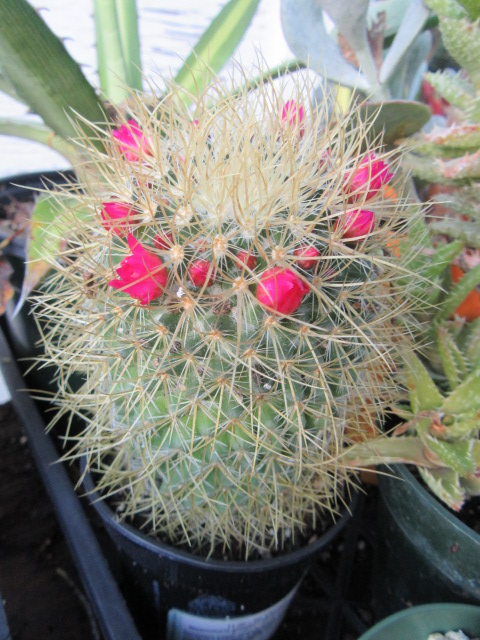
Mammillaria pringlei on 10-11-17, #382-50.
Of course, being a Mammillaria, it is covered with a multitude of tubercles that are arranged in a spiral pattern. The areoles on top of the tubercles produce 18-22 stiff white hair-like radial spines, 5-8 mm in length. Well, I measured them on my cactus and they are around 1/4” long. There are also 5-7 much thicker and longer central spines which is what you really notice about this cactus. The radial spines on my cactus are up to almost 1” long. The lower central spines are more or less straight while the upper ones are more or less recurved. The upper part of the plant has a small amount of wool on the areoles as well as a little in the axils (between the tubercles). I thought there was a big spot of wool on the side of the plant, but it turned out to be a spider web. 🙂

Mammillaria pringlei at 4 1/2″ tall x 3 1/2″ wide on 10-17-17, #384-17.
I measure the cacti periodically to see their rate of growth, usually when I bring them inside for the winter. Some grow so SSSSLLLLOOOOWWWW you need to measure them to make sure they are alive. Well, seriously, if they were dead they would turn brown and shrivel up. When I moved the plants inside for the winter on October 17 in 2017, the Mammillaria pringlei measured 4 1/2″ tall x 3 1/2″ wide and it is in a 3 1/2″ tall and wide pot.

Mammillaria pringlei from the top on 10-17-17, #384-18.
I really like the top view of cacti. The apex is so much different than the rest of the plant and the spines just seem to emerge and roll out… It is very hard to describe…

Mammillaria pringlei flower on 10-31-17, #387-19.
Mammillaria pringlei produce flowers just about any time of the year but mostly in June or July and in the fall after I bring the plants inside. I put this cactus on the kitchen windowsill for the winter with a few others in 2017. It received morning sun and did very well there.
<<<<2018>>>>

Mammillaria pringlei on 1-18-18, #401-9.
This species is one of many fast-growing cactus. Many, like this one, freely flower even at a young age which just adds more interest. I am not sure how many there are, but the top is LOADED with buds. It is so funny how long it takes for them to actually flower, though.

Mammillaria pringlei on 5-18-18, #444-18.
When warmer temperatures finally arrived I was able to take the plants back outside. (Ignore the plant to the right).

Mammillaria pringlei on 6-24-18, #463-8.
On June 24, in the late afternoon, I noticed the buds on the Mammillaria pringlei were getting larger…

Mammillaria pringlei on 6-28-18, #465-18.
Then on June 28, I was out earlier and some of the flowers were opened.

Mammillaria pringlei on 6-28-18, #465-19.
It is very interesting how its flowers are arranged in a circle around the top of the plant. The flowers grow from the previous year’s growth.

Mammillaria pringlei on 6-28-18, #465-20.
Later on, in the early evening, the flowers were closed up. They kind of look like tiny tulips.

Mammillaria pringlei on 8-18-18, #498-4.
Some cacti seem to be “leaners” no matter what. I straighten this plant up every time I re-pot it… If you don’t they will fall over.

Mammillaria pringlei at 4 7/8″ tall x 2″ wide on 10-10-18, #519-49.
I had to move the potted plants inside for the winter on October 10 because the forecast was calling for an “F” in a few days and the nighttime temperatures were getting cooler. I usually measure the cactus and succulents when I bring them inside. This time the Mammillaria pringlei was 4 7/8″ tall x 2″ wide (without the spines). Last year I screwed up and included the spines when I took measurements. So, with the spines last year it was 4 1/2″ tall x 3 1/2″ wide.

Mammillaria pringlei with buds on 10-10-18, #519-50.
On October 10 when I re-potted this cactus and measured it, I wrote down that it was 4 7/8 ” tall x 2″ wide (without the spines). As I was writing this on November 9, I thought it was bigger so I went to measure it again. This time it is 5 3/4″ tall x 2 1/2″ wide (without the spines). So, did it grow 7/8″ in a month while inside? Last year I screwed up and included the spines in their measurements so out of curiosity I measured it with the spines. Including the spines, it is currently 6 1/8″ tall x 3 1/2″ wide. Last year it was 4 1/2″ tall and 3 1/2″ wide with the spines… GEEZ! That is 1 5/8″ taller and the same width.
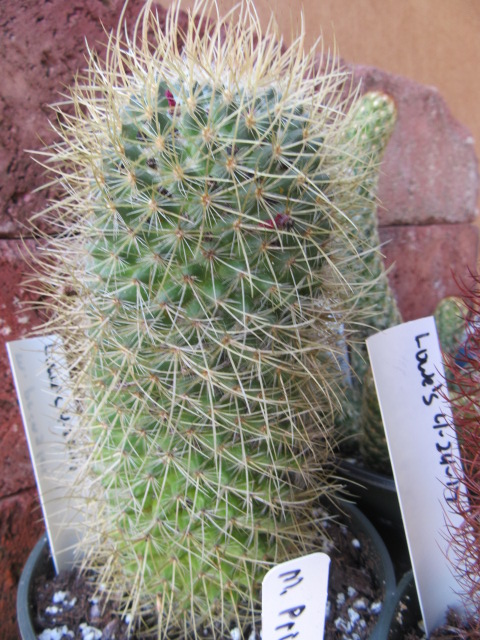
Mammillaria pringlei on 11-29-18, #534-25.
November 29 was a nice spring-like day, so I took the cactus to the back porch for a photoshoot. I was working on a post to show the difference between the cactus in my collection.
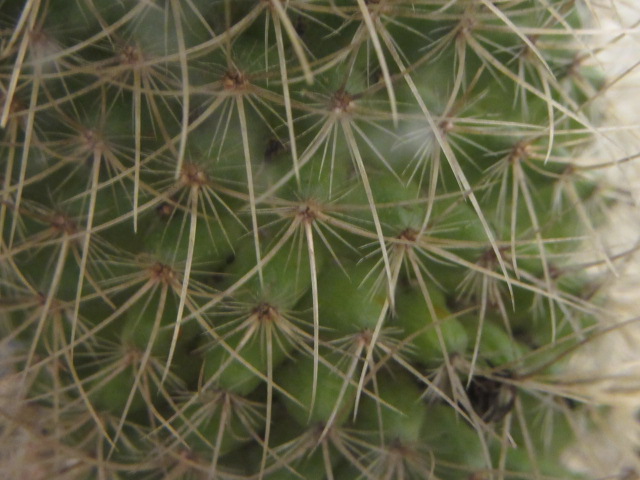
Mammillaria pringlei close-up on 12-1-18, #535-19.
Mammillaria pringlei is one of only a few species that have glowing golden spines. It has 18-22 radial spines and 5-7 central spines that are somewhat re-curved. Information says it is generally a solitary ball cactus that eventually divides dichotomously.
<<<<2019>>>>

Mammillaria pringlei on 6-22-19, #593-33.
I moved the plants to the front and back porches in May once temperatures warmed up enough. The above photo is the Mammillaria pringlei happily basking in the sun on the back porch on June 22.

Mammillaria pringlei on 7-4-19, #598-11.
LOOKING GREAT and starting to flower again on July 4. It is a bit wet because we had rain. 🙂

Mammillaria pringlei at 5 1/2″ tall x 2 1/2″ wide on 10-11-19, #639-71.
I had to move the potted plants back inside for the winter on October 10 because an “F” was in the forecast. I always photograph the plants when I bring them inside and take measurements of the cactus and some of the succulents. The Mammillaria pringlei measured 5 1/2″ tall x 2 1/2″ wide (not including the spines). It was 4 7/8″ tall x 2″ wide last year on October 10.

Mammillaria pringlei on 10-11-19, #639-72.
It took a short break and started flowering again…

Mammillaria pringlei on 10-19-19, #643-7.
Even though we had an “F” the temperatures warmed back up again. The cactus were giving me dirty looks so I put them back outside for a few more days.
<<<<2020>>>>

Mammillaria pringlei (Lemon Ball Cactus) at 5 3/4″ tall x 2 1/2″ wide on 10-15-20, #747-76.
I had to move the potted plants inside for the winter on October 15 (2020) because an “F” was in the forecast. As always, I took photographs and measurements. The Mammillaria pringlei did very well over the summer and measured 5 3/4″ tall x 2 1/2″ wide when I brought it inside.

Mammillaria pringlei (Lemon Ball Cactus) from the top on 10-15-20, #747-77.
This cactus is quite a bloomer…

Mammillaria pringlei (Lemon Ball Cactus) on 11-1-20, #754-3.
I took a few more photos of several Mammillaria species in my collection for the post Fall 2020 Update: The Mammillaria Group. This one is always great when it flowers.
<<<<2021>>>>

Mammillaria pringlei (Lemon Ball Cactus) on 6-24-21, #803-19.
The Mammillaria pringlei flowers periodically during the summer and was getting a good start when the above photo was taken on 6-24-21.
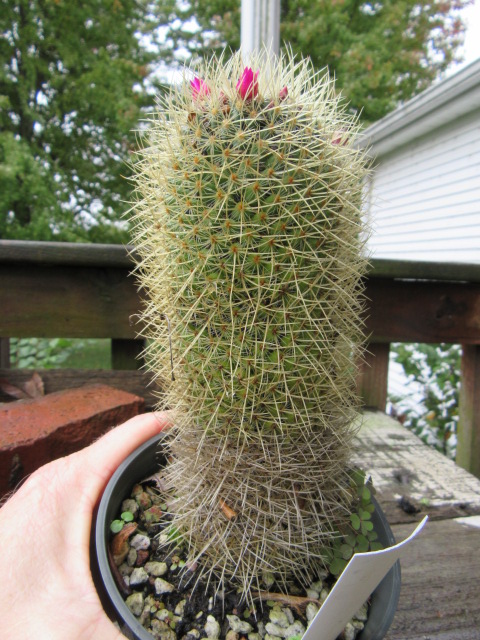
Mammillaria pringlei (Lemon Ball Cactus) at 6 1/2′ tall x 2 5/8″ wide on 10-28-21, #853-21.
I didn’t have to move the potted plants inside for the winter until October 28 in 2021. There wasn’t a chance of “F” in the forecast until then which was quite unusual. The Mammillaria pringlei did very well again over the summer and grew to 6 1/2″ tall x 2 5/8″ wide. It has leaned over the summer so I need to re-pot it and straighten it up.
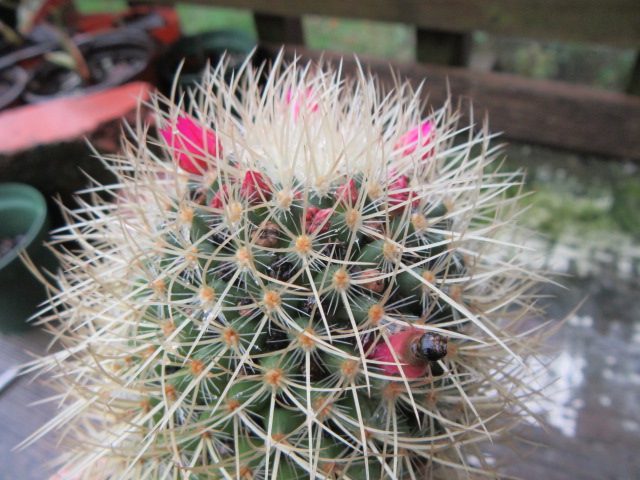
Mammillaria pringlei (Lemon Ball Cactus) on 10-28-21, #853-22.
Blooming again and it appears there is a fruit… Hmmm…
USEFUL INFORMATION:
Family: Cactaceae
Origin: Mexico
Zones: USDA Zones 9b-11 (25 to 40° F)
Size: 6-12”
Light: Sun to part shade
Soil: Fast-draining. Potting soil amended with pumice or perlite and grit.
Water: Average during the growing period, barely to none during the winter.
You can read my Cactus Talk & Update and Cactus & Succulent Tips to get my opinion about growing cactus and succulents.
When you bring your new plants home from the store, you need to check their roots and the soil to see if they are wet. If so, you may want to re-pot it right away. It is advisable to re-pot them in a better potting soil more suitable for cactus and succulents.
<<<<2022>>>>
Sorry to say, but both the Mammillaria pringlei and Mammillaria rhodantha didn’t make it through the winter. They had a small attack of mealybugs that I had to continually treat. Normally with cacti, all you have to do is use cotton swabs with alcohol and remove them or at least dab a little on the bugs. But the mealy bugs persisted. I used the same spray I have used in the past if I needed to, but in the end, both plants succumbed. I think it was the plants being treated constantly while they were dormant rather than the mealybugs that did them in. GEEZ! I hadn’t had any mealy bug issues until a couple of years ago after I received plants from an online store. Their plants were the first to have mealy bugs. Since then, I have had a few issues… You just never know…
The Mammillaria pringlei was a great cacti so now I will have to find another one to replace it…
I will continue adding more photos and information as time goes by. Be sure to check out the links below for additional information about the genus, species, and growing information. The links take you directly to information about the genus and species. There are many online sources for this species as it is very popular.
I hope you enjoyed this page and maybe found it useful. I would like to hear from you if you have any comments, questions, or suggestions. Please click on “like” if you visited this page. It helps us bloggers stay motivated. 🙂 Some information online lists this plant as Mammillaria rhodantha subsp. pringlei, but it is the same plant.
I get so excited when the cactus flower! I love the spines on this one!
LikeLiked by 1 person
Hello Diane! I am with you! The flowers always amaze me even though they are tiny. Mammillaria pringlei is definitely a nice cactus with a golden glow. Its cousin, M. rhodantha, has a nice reddish glow which I find very interesting as well. Thanks for the comment!
LikeLiked by 1 person